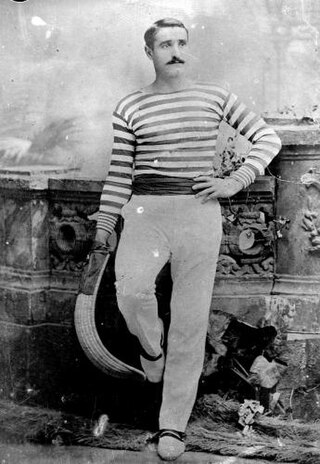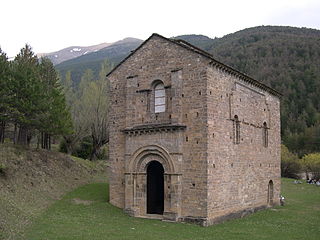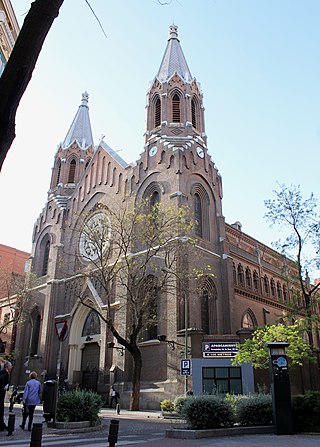
Jai alai is a sport involving bouncing a ball off a walled-in space by accelerating it to high speeds with a hand-held wicker cesta. It is a variation of Basque pelota. The term jai alai, coined by Serafin Baroja in 1875, is also often loosely applied to the fronton where matches take place. The game, whose name means "merry festival" in Basque, is called cesta-punta in the Basque Country. The sport is played worldwide, but especially in Spain, France, and in various Latin American countries.

Basque pelota is the name for a variety of court sports played with a ball using one's hand, a racket, a wooden bat or a basket, against a wall or, more traditionally, with two teams face to face separated by a line on the ground or a net. The roots of this class of games can be traced to the Greek and other ancient cultures.

Eibar is a city and municipality within the province of Gipuzkoa, in the Basque Country of Spain. It is the capital of the eskualde / comarca of Debabarrena.

Markina-Xemein is a town and municipality located in the province of Biscay, Bizkaia, in the Basque Autonomous Community, also known as the Basque Country, located in northern Spain. The origin of the town's name lies in its geographic location. The last town in the province of Bizkaia, Markina-Xemein lies between Gipuzkoa and Bizkaia. Coming from the Spanish word "marca" meaning "mark", Markina-Xemein marks the location where the Gipuzkoanos often battled the Bizkainos.

Plentzia is a town and municipality located in the province of Biscay, in the autonomous community of the Basque Country. The town has 4,331 inhabitants (2019).

Augusto Ibáñez Sacristán is a Basque pelota forward player. Champion of the Doubles Hand-pelota tournaments of 1994, 2000, 2004 and 2012.

Indalecio León Zarasqueta Uriarte, known as Txikito de Eibar or Aizpiri txiki, was a Basque pelota player who participated in pala, Hand-pelota, remonte, long bat and short bat categories. Due to his physical characteristics he received the nickname of Txiquito, meaning in Euskera Little. Txiquito de Eibar was one of the first professional players of pelota at the time of its beginnings, in the 19th century.
The Deportivo fronton is a Basque pelota fronton, used mainly in the modalities of hand-pelota, short bat, long bat, pala and paleta. It is located in Bilbao and owned by the local municipality. The 52-metre-long facility closed to the public in 2011, with events in the city moving to the Bizkaia fronton in the Miribilla district.

A fronton is a two-walled or single-walled court used as a playing area for Basque pelota.

A Bien de Interés Cultural is a category of the heritage register in Spain. The term is also used in Colombia and other Spanish-speaking countries.

The Church of Nuestra Señora de la Purificación of Gazólaz, located in the village of Gazólaz, municipality of Cizur is a romanesque church built at the start of the 13th century. In June 1931, it was declared Bien de Interés Cultural.

The Church of La Milagrosa, formerly Church of San Vicente de Paul, is a Roman Catholic church in Madrid, Spain. With an area of 900 square metres (9,700 sq ft), it is situated on Calle García de Paredes, west of the InterContinental Madrid. The church was built between 1900 and 1904 under the architects Juan Bautista Lázaro de Diego and Narciso Clavería y de Palacios. The architecture is eclectic, exhibiting Neo-Mudéjar features on the exterior and mainly Neo-Gothic features in the interior.

Pelota Mano Court is a heritage-listed sports ground at Trebonne Road, Trebonne, Shire of Hinchinbrook, Queensland, Australia. It was designed by Ford, Hutton & Newell and built in 1959 by Idillio Quartero and Ken Duffy. It is also known as Basque Handball Court and Fronton (court). It was added to the Queensland Heritage Register on 27 July 2001.

The old Pacífico Power Plant is a former power station belonging to the Madrid Metro. On 11 April 2013 the Directorate General of Historical Heritage of the Community of Madrid declared it a Bien de Interés Cultural. It is known by the name of its most important components, three massive diesel ship engines, and the Pacífico Metro station nearby.

Saint Isidore Cemetery is a monumental cemetery in the Spanish capital Madrid. Its first courtyard was erected in 1811 and new expansions were added throughout the 19th Century. Its central courtyard, called “Patio de la Concepción” boasts a notable group of mausolea. This cemetery is the resting place of many famous Spaniards, including artists, politicians and poets.

Barrio de San Lázaro is one of the first neighbourhoods in Havana, Cuba. It initially occupied the area bounded by Calle Infanta to the west, Calle Zanja to the south, Calle Belascoáin to the east, and the Gulf of Mexico to the north, forming the western edge of Centro Habana. According to the 1855 Ordenanzas Municipales of the city of Havana, Barrio San Lázaro was the Tercer Distrito and was Barrio No. 8.

The Edificio Carrión or Edificio Capitol is a building in central Madrid, Spain. An outstanding example of the expressionist-leaning trend within the wider scope of rationalist architecture in Spain, the building has become an icon of both the Gran Vía and the city.

The Monument to General Martínez Campos is an instance of public art in Madrid, Spain. Designed by Mariano Benlliure, it consists of an sculptural ensemble presided by an equestrian statue of General Arsenio Martínez Campos, who played a key role in bringing the Bourbon Restoration by leading the coup d'etat of Sagunto in 1874. It lies on the centre of the Plaza de Guatemala, in El Retiro.

There is an abandoned Jai alai court in the back of the Hermanos Ameijeiras Hospital, the site of the old Casa de Beneficencia, on Calles Concordia and Lucenas near Calle Belascoain, an area that had been considered in the early part of the city as a place to locate the helpless and the unwanted, it was the edge of the city and the countryside known as the "basurero"; the spectator stands were parallel to Calle Concordia, the front wall of the court faced Calle Lucenas, east in the direction towards Old Havana. The original building has been annexed by five stories of residential concrete construction on the north side along Calle Virtudes. The Havana Jai alai fronton was known as "the palace of screams".






















